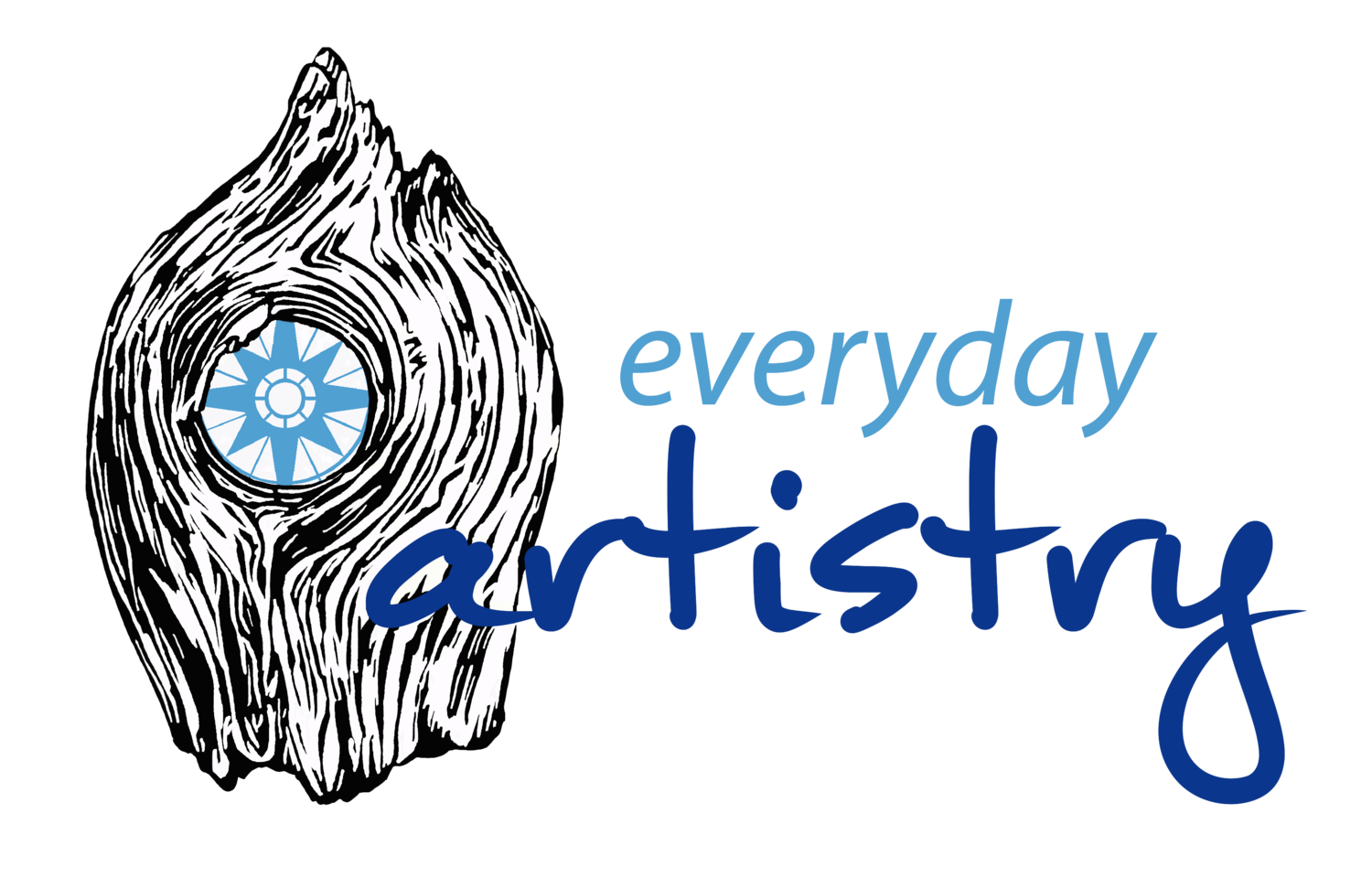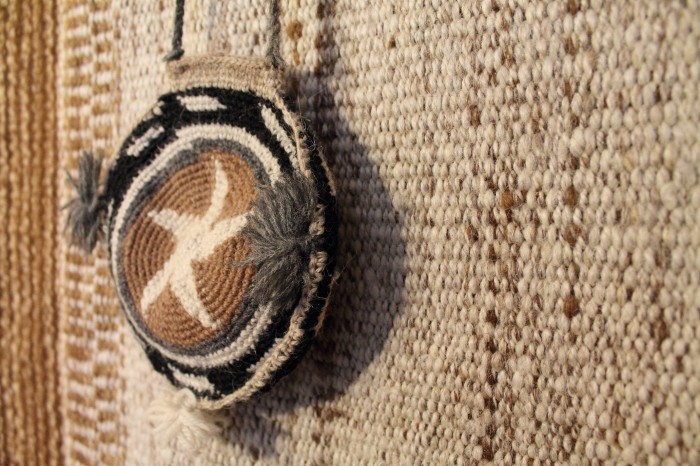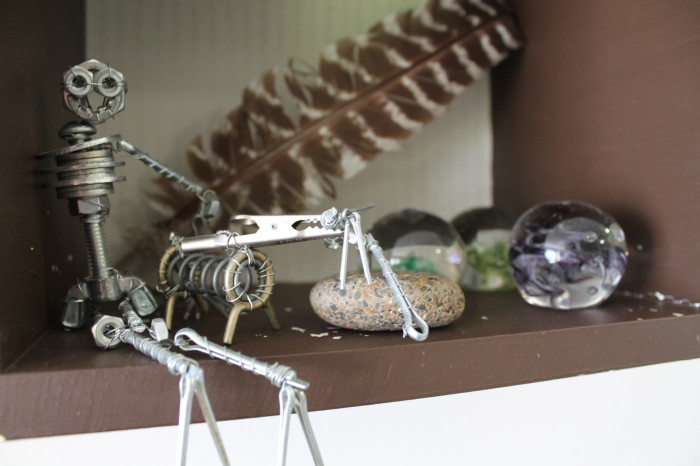This urge to say no, to not speak up, to not share ourselves with the world, becomes ingrained at an early age. We're afraid of rocking the boat, getting in trouble, getting made fun of. As Keith Johnstone writes in his book Impro: Improvisation and the Theatre, "We suppress our spontaneous impulses, we censor our imaginations, we learn to present ourselves as 'ordinary', and we destroy our talent--then no one laughs at us." I've spent many years suppressing my impulses, to the point where I often didn't think I had any. Maybe you've felt this way too and if you're tired of hiding, it might be time to start reconnecting with your impulses and learning to say yes.
The Year of Drawing Project
I still don't know what to call this project. All I know is that I want it to happen. I want to spend a year drawing as much as possible, learning to improve my skills, but more importantly, learning to calm the critical voices in my head that make drawing so unpleasant. I want to find a way back to childhood, back to when drawing was FUN.
Your creative self vs. your inner critic
Learning to Embrace Imperfection
Yesterday I came across Lisa Congdon's Doodling Manifesto. In it she talks about the importance of making a mark just for its own sake, and how every creative thing we do - no matter how messy or imperfect - is important. It gets us closer to who we are and to who we want to be. This struck me as a really important point. To be creative, we must learn to be imperfect. And not just imperfect: we must learn to make awful, terrible, ugly work just for the sake of making something. The more we make, the better we get.
Creative Experiment: Halfway Through
Back in November I started working through Marion Deuchar's book Draw Paint Print Like the Great Artists, committing to doing every single exercise.
I called this project a creative experiment because I wasn't really sure what would happen. I hypothesized that working through every exercise in this book would yield creative returns, but I didn't know what those would look like. I hoped that it would help me to develop some creative discipline and that I would get better at creative play. You can read more about my expectations about the project here.
How to make movement part of your creative tool kit
I really believe that our bodies know things that we might not consciously have access to and if we let them move, they will fill us in on their secrets. This isn't another New Years call to get yourself to a gym. This is just a gentle reminder that a moving body is a happy body - and movement can mean anything from stretching at your desk to dancing to scrubbing your baseboards. According to a study at Leiden University in the Netherlands, participants' performance on creative tasks went up when they were exercising regularly.
How to Prepare for Epiphanies: 5 Ways to Open up to Inspiration
Whether it's a massive shift in understanding or just a small flash of insight, epiphanies feel pretty good.These moments are rare, and that's what makes them magical, but do we have to wait around until something randomly bursts through the clouds? Or can we cultivate an environment where epiphanies are more likely? I think we can and lately I've been trying to figure out how. Here's what I've come up with so far.
Creative Challenge: #InspireOctober
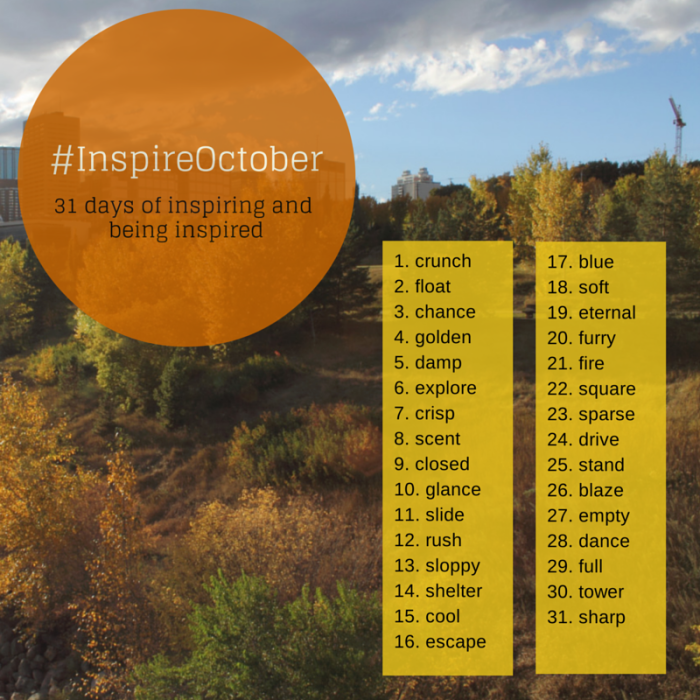 October is an amazing, crazy month. Birthdays, anniversaries, Halloween, Thanksgiving (my favourite holiday - and yes, here in Canada we celebrate it in October)... and I'm moving. The days are getting shorter, the last of the green leaves are turning colour and falling to the ground, and that inescapable winter chill is starting to creep in. It's a month of celebration and transition. What better time to sharpen my creative muscles and focus more clearly on the world around me?
This month, my creative challenge is back with #InspireOctober.
October is an amazing, crazy month. Birthdays, anniversaries, Halloween, Thanksgiving (my favourite holiday - and yes, here in Canada we celebrate it in October)... and I'm moving. The days are getting shorter, the last of the green leaves are turning colour and falling to the ground, and that inescapable winter chill is starting to creep in. It's a month of celebration and transition. What better time to sharpen my creative muscles and focus more clearly on the world around me?
This month, my creative challenge is back with #InspireOctober.
Last week I wrote about the importance of rituals, habits, and routines to help you stay creative every day. This week I have just the thing to help you with that goal! Introducing #InspireOctober, a 31-day creativity challenge that will inject some inspiration into your creative practice every day this month. It's easy to play along: Each number on the calendar is a day of the month. Using that day's prompt as a jumping off point, take a picture or write a short post and publish it on Instagram, Twitter, or Facebook with the hastag #InspireOctober. That's it! Full "rules" (there are no rules though, really) below. Enjoy!
The Mission:
To stretch our creative muscles a little bit each day in October. To open our imaginations and share our stories.
The Rules:
1. Use the words above as prompts to create a story: either a visual image or a small piece of text each day.
2. Post the story you create to Twitter, Instagram, or Facebook using the hashtag #InspireOctober, along with the word that inspired it. Follow me on these platforms for even more inspiration.
3. Interpret the prompts any way you want, literally or off-the-wall figuratively.
4. Use any media you want. Try to stretch a little bit and think about the different stories you can tell with each word. Will you sketch or paint a picture? Make a collage? Take a photo? Use found objects to make a sculpture? Take a video? Use found text? Transcribe overheard conversations? Create a map? Of course, if you want to use all photographs that’s fine too!
5. Do as many or as few as you want, in any order you want. I don’t want to stress anyone out, so make this challenge whatever you need it to be to have fun.
6. Share with your friends! The more people we have playing along, the more fun it will be.
The challenge starts tomorrow and will go to the end of October. I hope you’ll join in on the creative adventures!
Rituals, Routines, Habits: The Secret to Constant Creativity
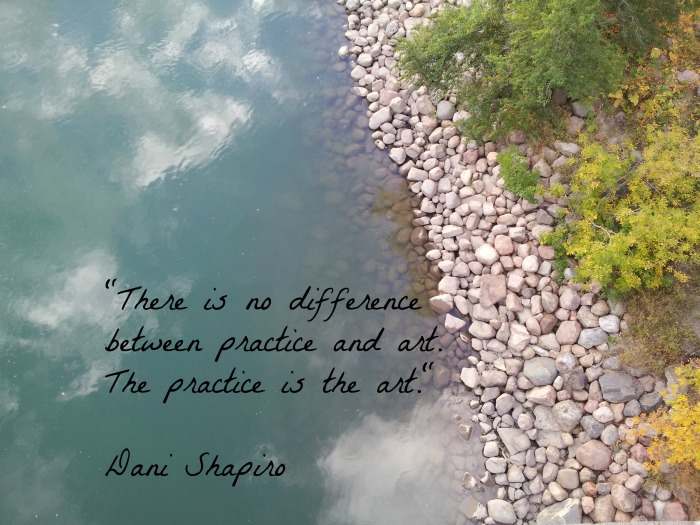
"If I waited to be in the mood to write, I’d barely have a chapbook of material to my name. Who would ever be in the mood to write? Do marathon runners get in the mood to run? Do teachers wake up with the urge to lecture? I don’t know, but I doubt it. My guess is that it’s the very act that is generative. The doing of the thing that makes possible the desire for it. A runner suits up, stretches, begins to run. An inventor trudges down to his workroom, closing the door behind him. A writer sits in her writing space, setting aside the time to be alone with her work. Is she inspired doing it? Very possibly not. But this is her habit, her job, her discipline. Think of a ballet dancer at the barre. She is practising, because she knows there is no difference between practice and art. The practice is the art."Dani Shapiro, Still Writing
Last year a friend gave me a Tarot deck for my birthday and I tried a reading for the first time. It was a time of upheaval and uncertainty so I asked the cards what was the next step I should take in my business. Many of the cards made a lot of sense but one that confused me a bit was the Hierophant card. Here's an interpretation: "The Hierophant Tarot card suggests that you may be wise to follow established social structures and traditions. You may be involved in some sort of ritual, ceremony, or the trappings of religion. There is also a need to honour some tradition in your life, or maybe start some traditions of your own if you have none."
After thinking about it for a bit it became clear what kind of "rituals" and "traditions" the card was asking me to try. Creative rituals.
"It’s vital to establish some rituals -- automatic but decisive patterns of behavior -- at the beginning of the creative process, when you are most at peril of turning back, chickening out, giving up, or going the wrong way.
A ritual, the Oxford English Dictionary tells me, is a “prescribed order of performing religious or other devotional service.” All that applies to my morning ritual. Thinking of it as a ritual has a tranforming effect on the activity.
Turning something into a ritual eliminates the question, Why am I doing this? By the time I give the taxi driver directions, it’s too late to wonder why I’m going to the gym and not snoozing under the warm covers of my bed. The cab is moving. I’m committed. Like it or not, I’m going to the gym.
The ritual erases the question of whether or not I like it. It’s also a friendly reminder that I’m doing the right thing. (I’ve done it before. It was good. I’ll do it again.)"
Twyla Tharp, The Creative Habit
In 2014, one of my 3 resolutions was to establish new habits of creative productivity. You can read about the goal-setting process here and my system for staying accountable to these resolutions here. The quick version is that every week I come up with a new mission to help me get closer to my goals. Since I've also been reading everything I can get my hands on about creativity, I've been paying close attention to what other creative people have written about habits and incorporating these ideas bit by bit into my weekly missions.
"It doesn't matter what the deal is that you strike with yourself, as long as you keep up your end of it, that you establish a working routine for yourself, a rhythm. I prefer to think of it as rhythm rather than discipline. Discipline calls to my mind a taskmaster, perhaps wielding a whip. Discipline has a whiff of punishment to it, or at least the need to cross something off a list, the way my son Jacob does with his homework. Rhythm, however, is a gentle aligning, a comforting pattern in our day that we know sets us up ideally for our work."
Dani Shapiro
Some of the things I've tried to help establish rhythm in my own life include:
- Moving down from full time to part time work so I have two whole days to create
- Getting chores done on Sundays or evenings during the week to protect my creative days and keep them open
- Doing creative work first thing in the morning - writing when I'm at the office (I have a lot of free time at my job) and developing new projects at home. I always start with the hardest thing, the thing that I would rather avoid doing.
- Writing down a numbered list of projects for each day. Instead of scheduling blocks of time, I just number my to-do items in order of priority. This helps me fluidly move from one thing to the next at a comfortable pace. When it's time for the next thing on the list, I jump in and do it, whether I feel like it or not.
- Keeping track of time spent on all creative work and trying to increase the count each week
- Creating and keeping up with online creative challenges every other month (there's one coming up in October!)
- Working on projects just for me - not to sell - to experiment and develop my skills
"There’s a paradox in the notion that creativity should be a habit. We think of creativity as a way of keeping everything fresh and new, while habit implies routine and repetition. That paradox intrigues me because it occupies the place where creativity and skill rub up against each other."
Twyla Tharp
If these things sound really organized, methodical, clinical - the opposite of creative - that's because they are. My goal is to make space for creativity by creating routines. If I don't have to wonder about what to do next, if I have fewer decisions to make then I have more juice, more creative energy left. I want to make creative production as seamless and easy as possible so that, rather than fighting with myself to sit down at the computer or the craft table, I end up there without even realizing how I did it. I'm not there yet - certain days are easier to program and my plans frequently go off the rails. But I have noticed my production increasing, my ideas increasing, my level of satisfaction increasing - which is why we do this after all, isn't it?
“I keep to this routine without variation. The repetition itself becomes the important thing; it’s a form of mesmerism. I mesmerize myself to reach a deeper state of mind.”
Haruki Marakami
Will you join me in making creativity a part of your daily life? How can you set up routines, rituals, rhythms, habits to help you get there? Leave a comment below!
All this Stuff: The Objects that Inspire Me
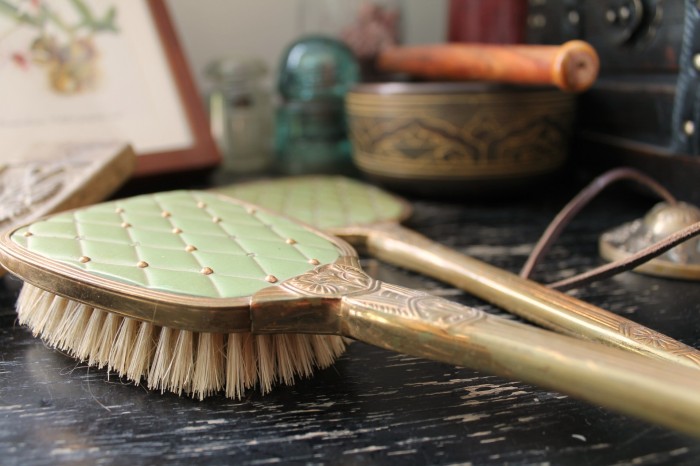 Like many people, I collect objects and images and use them to decorate my home. Some have flown with me across oceans, some were made by friends and my boyfriend, and plenty are gifts from people I love. I have always loved having these objects out where I can see them - minimalism is definitely not for me. When I met my boyfriend and saw that his apartment was crowded with his own collection of objects of wonder, I knew that we would get along fine.
Sometimes I feel guilty for feeling so connected to objects, and I sometimes wonder - why these things? What is it about them that makes me never tire of looking at them?
Like many people, I collect objects and images and use them to decorate my home. Some have flown with me across oceans, some were made by friends and my boyfriend, and plenty are gifts from people I love. I have always loved having these objects out where I can see them - minimalism is definitely not for me. When I met my boyfriend and saw that his apartment was crowded with his own collection of objects of wonder, I knew that we would get along fine.
Sometimes I feel guilty for feeling so connected to objects, and I sometimes wonder - why these things? What is it about them that makes me never tire of looking at them?
In her book The Creative Habit, Twyla Tharp talks about creative DNA: "I believe that we all have strands of creative code hard-wired into our imaginations. These strands are as solidly imprinted in us as the genetic code that determines our height and eye color, except they govern our creative impulses. They determine the forms we work in, the stories we tell, and how we tell them."
I think these objects are part of my creative code. When I look closely I see that certain themes come up again and again: navigation, exploration, and discovery are big ones, along with a sense of history, and of being very far away in place in time. These themes underlie my art (my obsession with maps and old things) and my life (I feel a constant urge to explore, to learn, and to venture further and further afield).
Some of the things you'll find taking up space in my tiny bachelor apartment include: postcards from an exhibit I saw in Edinburgh called "Amazing Rare Things: The Art of Natural History in the Age of Discovery", an old map of the north of England that my boyfriend had beautifully framed for me, an old window frame filled with dried flowers made by a local artist, a vase full of dried local grasses, weavings from Peru, and large wall-hanging that I made in Argentina, glass insulators from the tops of old telephone poles (we used to go looking for them in ditches with my dad), an antique mirror and brush that I bought while visiting a friend in northern Alberta, a sock puppet a friend made for me when I went away for a summer, a Kachina doll I bought in Arizona, a fan my brother brought from Japan next to one from New Orleans, a tea pot my mom gave me when I moved out.
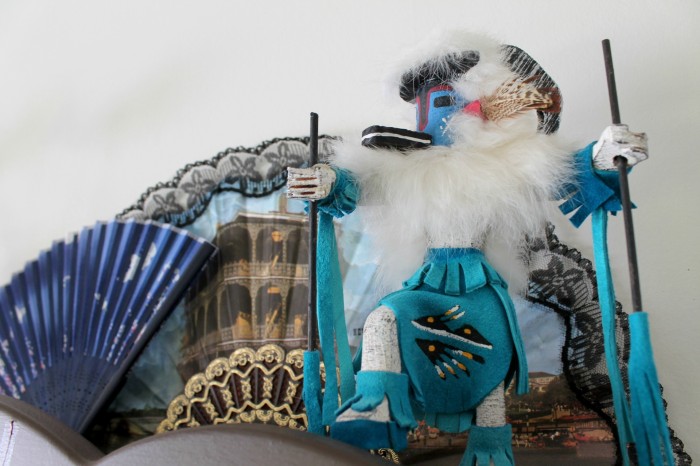
To me, these things evoke the feeling of a jumbled 19th century museum, with strange new treasures around every corner. Natural history, textile arts, maps. They provide a record of what I have already discovered and inspire me to continue exploring. Even the colour schemes that I'm drawn to are straight from the dark corners of of a natural history display - the deep rich woods of old cabinets, the dusty beiges of dried plant matter and animals, the occasional shock of green or pink from a faded botanical print. This explains, perhaps, why I keep dead plants around, despite their supposedly bad fung shui, and why I still have the vertebrae of a cow that I found in a field when I was eight years old. That slightly morbid fascination with things that have long since died gives a clue as to why I currently feel compelled to create sculptures of hearts and eyeballs, and why I cover them with old, found papers.
This isn't even all of it. I have a box full of items that didn't make the cut - a quote from a poem written in Chinese calligraphy that I watched being made in the Chinese garden in Portland, weavings made by one the best weavers in all of Bolivia, and the pieces that she taught me to make, postcards from Chicago, New York, Santa Fe, Buenos Aires, Lima, and plenty more maps. I dream of one day having a library where I'll be able to display everything and have a visual inventory of my travels through space and time.
I'll be moving in with my boyfriend in a couple months and will have to pare down even more and be extra choosy about what will be displayed and what will be stored. What will stay and what will go? And how will he and I decide how to merge our creative code and tell our shared story? I can't wait to find out.
What objects are part of your creative code? What do you keep around to remind you of who you are and what's important to you? Leave a comment below.
